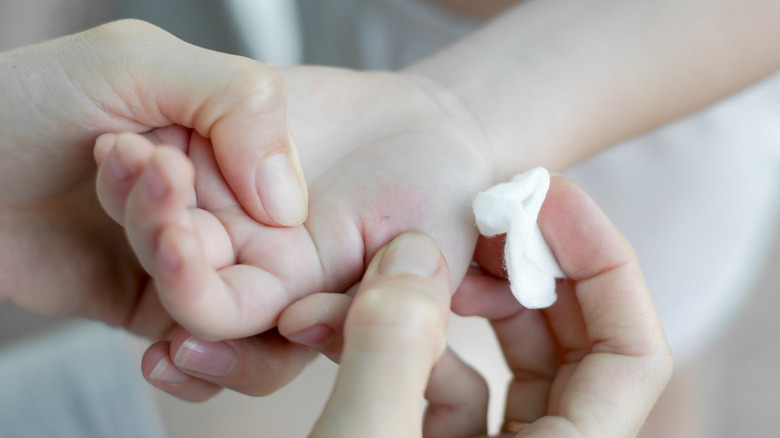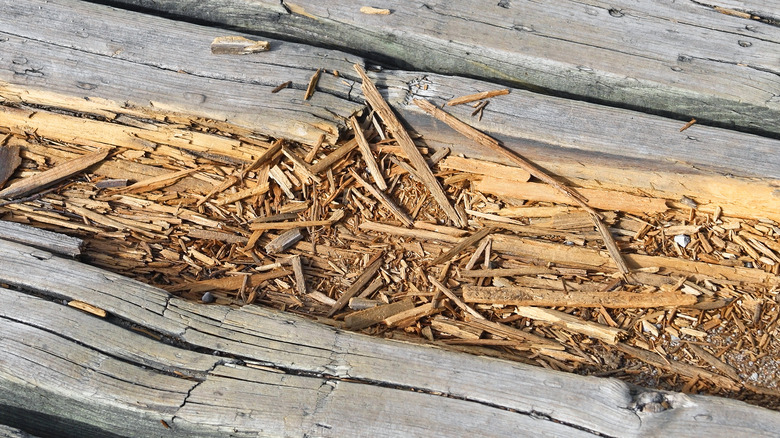How Getting A Splinter Could Cost You Your Life
Most of us probably think splinters are no big deal. After all, they are pretty common. Unless you grew up in a bubble, most people have probably had at least one splinter in their life, and while they may be annoying and even painful, they aren't exactly a debilitating injury. At least, not most of the time. However, in some rare cases, a splinter could become a life-threatening wound.
Splinters are very small foreign objects that get lodged underneath the skin's surface, according to Kids Health. While wooden splinters are probably the most common, glass, metal, plastic, and other debris can also become embedded in the skin, causing redness, swelling, and pain. In most cases, splinters can be easily dealt with at home. The injury is typically treated by removing the splinter from the skin with sterilized tweezers and washing the surrounding area thoroughly with soap and warm water. But while most people can simply remove minor splinters and be on their way, this is not always the case.
Splinters can cause inflammation and infection
In some instances, splinters can turn deadly. When a wooden splinter gets lodged in the skin, it may also bring along with it oils, resins, or other substances that may react negatively with the body, according to How Stuff Works. These foreign substances may cause inflammation, and if the substance happens to be particularly toxic, as in the case of thorny poisonous plants, it may lead to a serious, and potentially lethal, illness.
Additionally, objects that cause splinters can be prime breeding grounds for bacteria, which can lead to infections. If the area around the wound is not thoroughly cleaned and an infection forms, serious reactions can occur. Infected splinters can become red, inflamed, swollen, and begin leaking pus, and in very serious cases can cause fever and swollen lymph nodes, according to Skin Sight. Serious infections can affect the respiratory and cardiac systems, and may even lead to death if not treated quickly. Therefore, if a splinter becomes infected, inflamed, or doesn't appear to be healing properly, it is always a good idea to consult a doctor.
"In general, any splinter that penetrates through the full thickness of the skin into the tissue below needs to be seen by a health care provider," advises Dr. Daniel Bates, an urgent care physician (via Banner Care) "to determine whether the wound needs to be explored and whether preventive antibiotics need to be prescribed. This is particularly true for treated wood products."
Some splinters can be large
Furthermore, not all splinters are tiny. Sometimes, large pieces of wood can become embedded in the skin, posing a threat to internal organs or blood vessels, according to How Stuff Works. However, both large and seemingly minor splinters can pose a risk. One of the most serious conditions a splinter can lead to is an illness known as tetanus, which affects the nervous system as the result of toxin-producing bacterium, according to the Mayo Clinic. Luckily, tetanus shots are readily available in most clinics, and most people are immunized against tetanus as children.
But while it is always a good idea to take precautions, ultimately, life-threatening splinters are extremely rare. And there are a few easy ways to avoid encountering any splinters, lethal or otherwise. It is generally a good idea to wear shoes, especially on wooden structures like decks or docks. People should also use caution when touching wooden or metal surfaces, and should take care to avoid coming into contact with sharp, thorny plants, according to Kids Health. But as long as people try to be careful, and keep an eye on their wound if they do end up getting pricked, they should be able to stay safe and healthy.


